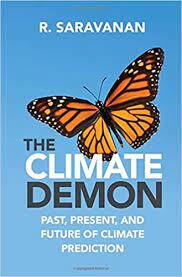Ramalingam Saravanan *90 Explains How to Interpret Climate Models
The book: The Climate Demon (Cambridge University Press) takes the complex science and research behind climate models and makes them accessible for the general reader. Ramalingam Saravanan *90, an expert on the mathematical and physical aspects of the climate system, takes readers by the hand to explain how to interpret and use the predictions climate models provide. Although models don’t have all the answers, Saravanan argues they are a valuable tool to address climate change. 
Excerpt:
Our climate prediction story begins in the historic town of Princeton, New Jersey. The town was the site of a battle during the Revolutionary War; after the war, in 1783, Princeton served for four months as the provisional capital of the United States. Today it is best known as the home of Princeton University. Through the center of town runs Nassau Street, which began as part of a Native American trail that later became a stagecoach route between New York and Philadelphia. This street marks the divide between “town” and “gown”: To the north lives the general population of Princeton, and to the south lies the picturesque campus of Princeton University with its neo-Gothic architecture.
On Nassau Street’s north side, across from the university, there is a wonderful independent bookstore called Labyrinth Books. Here, for the affordable price of $7.95, you can buy yourself a whole year’s worth of weather and climate forecasts. These forecasts are found in the annual edition of a little book called the Old Farmer’s Almanac, which has proudly provided this service every year for more than two centuries. For each of eighteen different regions of the United States, the almanac lists quantitative predictions of the average temperature and precipitation for each month of the year, as well as qualitative weather forecasts for individual periods of these months. The almanac even features a thoughtfully placed hole in its top left corner so that it can be hung from a nail in the barn or the outhouse, enabling convenient perusal of its folksy weather-related articles and tables.
Historically, the almanac used a secret formula for weather forecasts, devised in 1792 by its founder, Robert B. Thomas. This formula is based on the premise that “nothing in the universe happens haphazardly, that there is a cause-and-effect pattern to all phenomena.” Thomas believed that the sun had an effect on the Earth’s weather, and he credited Italian astronomer Galileo Galilei’s seventeenth-century study of sunspots as a key part of his secret formula. Farmers — the almanac’s original target customers — needed to know, for instance, when the first snow of the year would fall in order to plan their harvests. Even townsfolk could benefit from advance knowledge of sunny days on which to plan a wedding or a picnic. The longevity of the almanac demonstrates its success in catering to the practical needs of farmers and townsfolk over the years. But the venerable almanac does have competition in the folksy prediction market: Since 1887, a groundhog named Phil has been prophesying the start of spring in the town of Punxsutawney, Pennsylvania. We shall make further acquaintance of this furry forecaster later on.
For decades, while the Old Farmer’s Almanac and, later, Punxsutawney Phil made their prognostications, the “gown” part of Princeton — the scientists in the ivory towers of the university — remained largely silent on the subjects of weather and climate prediction. That began to change in the late 1940s, with the invention of the digital computer.
Let us walk south from Labyrinth Books through the university campus, past Nassau Hall (which served as the capitol building while Princeton was briefly the nation’s capital). We eventually arrive at Jones Hall. This well-appointed building with carved oak paneling modeled after colleges at Oxford University currently houses the departments of East Asian Studies and Near Eastern Studies. Let us go back in time to 1931, when this building was built. It was then the new home of the mathematics department. It also had a different name, Fine Hall, after the beloved and well-respected math professor Henry B. Fine. (The building’s name was changed to Jones Hall in 1969, when the mathematics department moved to a new building. That building inherited the name Fine Hall.)
One of the occupants of Fine Hall in 1931 was the man who helped design it, a mathematician named Oswald Veblen. Mathematics faculty were generally burdened with heavy teaching duties. Therefore, Veblen nursed a grand vision of a new science institute, a true ivory tower, in which faculty would focus only on research. He managed to persuade an educator named Abraham Flexner, who was already in the process of setting up an institute of this nature, to locate it in Princeton. Known as the Institute for Advanced Study (IAS), it would bestow renowned scientists with lifetime appointments as professors, with no teaching responsibilities. There would additionally be a regular flow of short-term visiting scientists to the institute.
Flexner, the founding director of the IAS, was a strong proponent of curiosity-driven research; he published an essay with the provocative title “The Usefulness of Useless Knowledge.” He persuaded a wealthy New Jersey family, the Bambergers, to contribute the equivalent of $200 million today to his project. A permanent building was to be constructed for the IAS using these funds, about a mile from the main campus of Princeton University. In the meantime, though, Flexner needed to find a temporary office for the scholars who would comprise the institute. Fine Hall was ideal for this purpose; the new members of the IAS could interact with the mathematicians already there, as well as with the physicists in the adjacent Palmer Physical Laboratory (which is now the Frist Campus Center).
All was settled, and the IAS began operations in Fine Hall in 1933. Among its early recruits was the world-famous physicist, Albert Einstein. Another was a young mathematician named John von Neumann, who published his first mathematics paper before the age of eighteen. Von Neumann, the son of a wealthy banker, was born in 1903 in Budapest, Hungary. He was a prodigy who reportedly had the ability to recall entire books; before he joined the IAS, he had already written an influential book on the Mathematical Foundations of Quantum Mechanics. In 1935, von Neumann visited the University of Cambridge in England. There he met a young mathematician named Alan Turing *38, who was working on fundamental problems relating to the mathematics of computability. Intrigued by Turing’s research, von Neumann encouraged him to come to Princeton.
After receiving his degree from the University of Cambridge, Turing arrived in Princeton in 1936 to start his Ph.D. under Alonzo Church, a professor in the Department of Mathematics. Between 1936 and 1938, Fine Hall housed Einstein, von Neumann, and Turing, three of the most legendary names in physics, mathematics, and computer science — the last being a field which did not even exist at the time. These three fields would come together in Princeton to birth the fields of numerical weather prediction and numerical climate prediction.
In a landmark 1936 paper, “On Computable Numbers, with an Application to the Entscheidungsproblem,” Turing conceived of a universal computing machine with an infinite tape — a tape that the computing machine could read symbols from, write symbols on, or erase repeatedly. The tape could move forward or backward under the direction of the machine. This conceptual machine, now known as a Turing Machine, could carry out any computation which involved well-defined steps. Turing used this hypothetical construct to show that there were numbers that could not be computed using this machine. This led to the conclusion that there was no general computing procedure to prove if a computer program would eventually halt. In essence, Turing had invented a universal computing machine to prove the limitations of computing. This paper forms one of the foundations of the field of computer science.
In Princeton, Turing continued to work on problems related to computation. However, with the offices of luminaries such as von Neumann and Einstein just down the corridor from him, he felt that his own work would not be recognized. After Turing completed his Ph.D. in 1938, von Neumann tried to persuade him to stay by offering him a research position at the IAS, but Turing decided to return to England. In the years following, von Neumann continued to be fascinated not only by the idea of building computing machines but also by the possibility of their practical utility.
Among the mathematicians of the IAS, von Neumann was somewhat of an oddity. He could hold his own among theoreticians like Einstein and Kurt Gödel, the great mathematical logician who had visited and later been recruited to the IAS. Gödel’s work is about as theoretical as it gets: He is famous for proving the Incompleteness Theorem, which demonstrated the limits of mathematics and inspired Turing’s work on the limits of computation. But, unlike either Einstein or Gödel, von Neumann was very much interested in useful application of “useless knowledge,” that is, the practical applications of science such as hydrodynamics, meteorology, and the design of ballistic and nuclear weapons.
Being both a physicist and a newly minted computer scientist, von Neumann realized computers could be used to predict weather from basic physical principles. But the Turning Machine, while a beautiful concept, was not a practical computer design. (It required an infinite tape, for instance.) So, von Neumann set out to design and build an electronic computer at the IAS. Due to such a computer’s potential military applications, von Neumann was able to convince the US Atomic Energy Commission and various military agencies to fund this expensive endeavor. While he waited for the IAS machine to be built, von Neumann would use the world’s first general-purpose computer, the Electronic Numerical Integrator and Computer (ENIAC) — which was designed by another scientist interested in weather prediction.
From The Climate Demon by Ramalingam Saravanan Copyright © 2022. Reproduced by permission of Cambridge University Press
Review:
“If you wish to correctly interpret climate modeling results, read The Climate Demon. Saravanan’s brilliant and humorous book helps both scientists and the general public objectively understand strengths and limitations of climate predictions.” — Samuel Shen, distinguished professor, San Diego State University












No responses yet